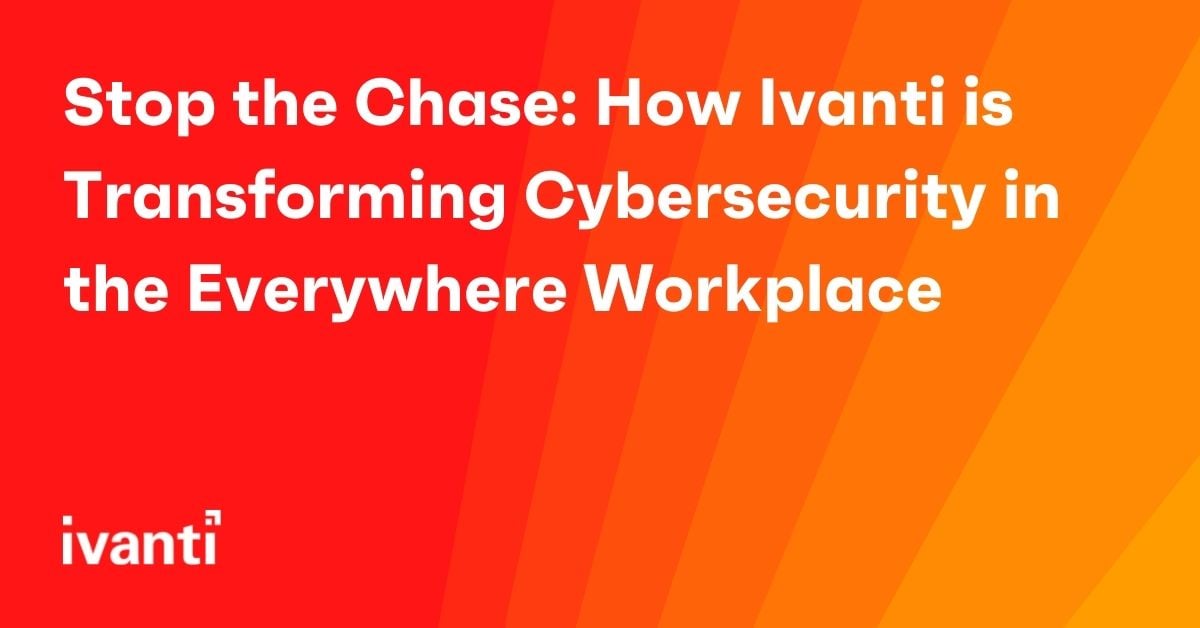Stop the Chase: How Ivanti is Transforming Cybersecurity in the Everywhere Workplace
Threat actors have been a constant, persistent, and ever-evolving part of doing business in a digital world. For the entire history of digital business, security teams have been trying to keep pace with the threats. On a good day, they might be able to get a few steps ahead. But it’s always a chase. And it only takes falling behind one time to lose big.
This has never been more clear than it is today. The pandemic catalyzed an abrupt shift to remote work, and teams scrambled to get everyone securely connected and supported. Threat actors seized on an unprecedented opportunity. Attackers have increasingly waged phishing attacks at mobile devices, which remote workers are using more than ever before. Where corporate email used to be a key security gap, now it’s email plus via text and SMS messages, instant messages, social media, and other modes of communication.
According to a recent survey by Ivanti, nearly three-quarters (74%) of respondents said their organizations have fallen victim to a phishing attack in the last year, with 40% confirming they have experienced one in the last month. A whopping 58% of those surveyed also said their organizations have suffered a ransomware attack in the past year. Of those organizations that suffered a ransomware attack, the majority (53%) said it took between one to four weeks to recover.
Unfortunately, as threat actors continue to get more sophisticated, many organizations still struggle with prioritizing the patch management process and remediating critical vulnerabilities, such as those tied to ransomware. High-profile zero days are being used by threat actors within hours of release, and security teams can’t respond fast enough. In some cases, IT systems are difficult to patch because they cause outages. It’s the perfect storm of poor visibility due to the recently decentralized workforce and the growth of sophisticated threat actors targeting critical vulnerabilities.
Security teams are tired. Employees are concerned about maintaining productivity – and about inadvertent exposures. They’ve all been in a nonstop race against threats, with no clear finish line.
Everywhere security for the Everywhere Workplace
Ivanti is calling off the race. Not because we’re giving up. Quite the opposite, in fact. We’re changing the rules forever, so security teams can stop chasing and start moving forward on a new path – one marked by hyperautomation and innovation, where threat actors don’t even get to toe the start line. We call it “fighting the good fight.”
Ivanti has doubled down on its mission to secure the Everywhere Workplace, declaring a commitment to protecting our customers and mitigating threats as quickly as possible. We’re relentlessly focused on outcomes, because it’s not enough to develop excellent products. We need them to work. (And they do.)
Hands off
Our hyperautonomous platform makes it possible to discover, manage, secure and service every asset, everywhere. That means automatically securing the brand, people and data that a business needs to thrive in – not just survive – the Everywhere Workplace.
Hyperautomation is a critical component of this platform, because it means Ivanti can find, heal, and protect devices without manual intervention or excess downtime. A security team doesn’t need to chase every threat, because the platform assumes that bad actors are always on the network and responds accordingly. Whether your team is down the hall or around the globe, they’re covered – even when an asset is offline.
Zero trust, 100% visibility
That leads to another key element of how we’re fighting the good fight: zero trust. Zero Trust security enables organizations to achieve a stronger and more impenetrable network by continually verifying each asset and transaction before permitting any access. President Biden recently signed an Executive Order requiring federal agencies to quickly develop plans to implement Zero Trust Architectures. Yet all organizations – not just federal agencies – should implement a Zero Trust strategy to achieve comprehensive visibility across users, devices, apps, and networks, and combat growing cyberthreats.
To help all organizations modernize their cybersecurity approaches and comply with President Biden’s Executive Order, Ivanti recently announced that it is collaborating with NIST’s National Cybersecurity Center of Excellence (NCCoE) in the Implementing a Zero Trust Architecture project. As a collaborator, Ivanti is helping to develop practical, interoperable approaches to designing and building Zero Trust architectures.
Risk-based intelligence
Fighting the good fight means being prepared and proactive. That’s why Ivanti recently acquired RiskSense, a pioneer in risk-based vulnerability management and prioritization, to revolutionize patch management. By leveraging risk-based intelligence for patching, teams can shrink their attack surface and help ensure that the highest-priority risks are being addressed at the right time. That means less wasted time and fewer gaps.
Not chasing doesn’t mean we’re ready to sit down and rest. Part of our commitment to revolutionizing cybersecurity means constant innovation. We’re continuing to educate and spread the word while serving as a champion for our customers. Because at the end of the day, that’s who we’re doing this for. We want them to stop having to chase too. When you stop chasing, you can start putting your energy toward carving out the path forward.

